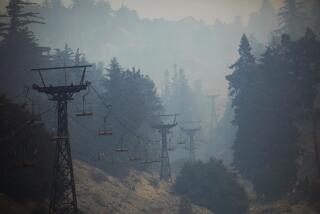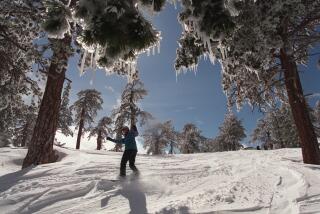Slush fun
Ski resorts once scrambled to stay open past Easter, often competing to see how far they could stretch their seasons into summer.
With a few exceptions, those days appear to have vanished like a patch of powder on a sunny day, victims of the changing economics of the ski industry. These days, most ski areas shut down in mid-April.
Last year, for example, the Colorado Rockies received some late snow dumps, but most resorts still shut down, unable to draw enough customers as outdoor interests shift to backpacking and other warm-weather pursuits.
Luckily for those who prefer skiing in T-shirts, there are still some holdouts.
“Some resorts may have snow, but not enough people to justify running the lifts,” says Craig Albright, the sports school director at Mammoth Mountain, which consistently has the longest ski season in California.
Mammoth closed last year on June 15 and plans to try to stretch to July 4 this year. The resort has a healthy snowpack (currently about 120 inches) and an elevation of 9,000 feet at the main lodge and cold temperatures at night that help stave off the effects of spring’s strengthening sun on the snow.
Other big resorts that push their seasons well into spring include Squaw Valley near Lake Tahoe, Oregon’s Mt. Bachelor, Timberline and Arapahoe Basin in Colorado (pictured above).
Spring skiing is tricky because conditions change quickly. By May and June, it may be best to plan on only two or three hours of skiing, to take advantage of optimum conditions.
This involves following the sun and navigating around the mountain to catch the snow before it turns into a giant Slurpee.
Slope “aspect and timing are everything,” says Albright, who advises hitting east-facing slopes in the morning because they catch the sun earlier, which softens up anything that iced up overnight.
As those slopes become mushy, savvy spring skiers move to the north-facing slopes, working eventually to west-facing runs in the afternoon.
One of the joys of spring skiing and snowboarding is corn snow -- ball-bearing-like crystals that sit about an inch deep on the surface early in the day. Skis and snowboards glide easily in corn, unlike in heavier, wetter “Sierra cement,” when they can stick like glue to the snow.
Corn forms during extended periods of cold nights and warm days -- conditions currently well underway throughout the Sierra. “Ego snow” is what S.P. Parker calls corn. Parker, an avid backcountry skier and an owner of Sierra Mountain Center in Bishop, says corn is just about the easiest snow to ski, especially if steeper runs normally give you the willies.
Parker’s company runs backcountry “corn camps” in Rock Creek Canyon, in which participants camp at night and corn-hunt by day. “California probably has the best corn snow in the world,” he says, with the Sierra Nevada producing the most predictable corn.
One corny treat in Squaw Valley is a run open only in the spring. Once things “corn up” on the far side of the Granite Chief area, “Smoothie” opens daily from 9-10 a.m., says Becky Moore, a resort spokeswoman. This run, just within the ski area boundary, is kept ungroomed and open only when corn conditions are optimal.
Spring snow does have a downside. After about 11 a.m., that crisp corn can turn into a mealy mush. Carving turns becomes more like water-skiing. Wider, shaped skis with more sidecut can help get through the gooey stuff.
One way to combat this problem in May and June: Leave. After all, it’s spring and there’s still plenty of daylight for activities truly meant to be done in the blazing sun.
To e-mail Julie Sheer or read her previous Outdoors Institute columns, go to latimes.com/juliesheer.
More to Read
Sign up for The Wild
We’ll help you find the best places to hike, bike and run, as well as the perfect silent spots for meditation and yoga.
You may occasionally receive promotional content from the Los Angeles Times.






